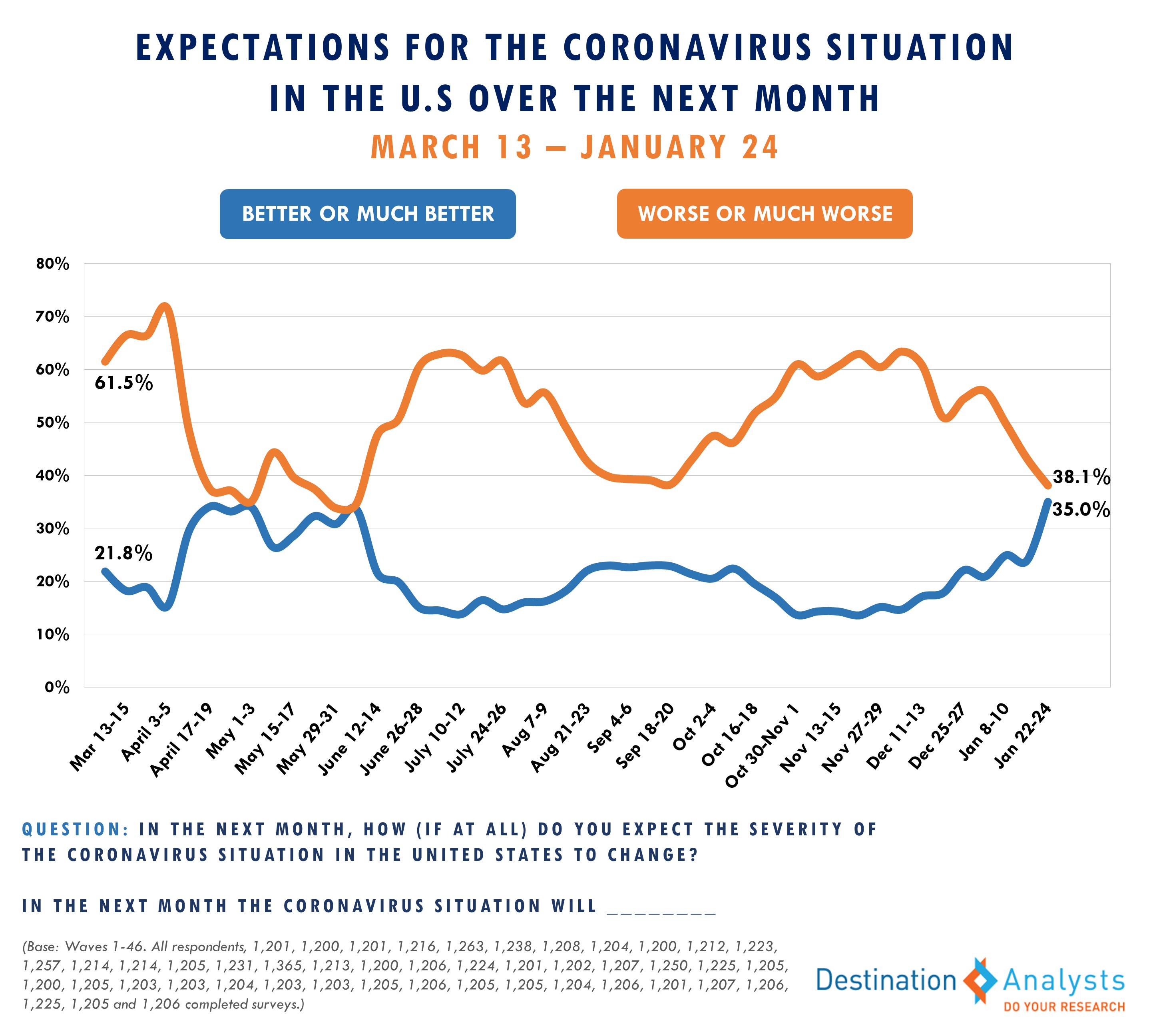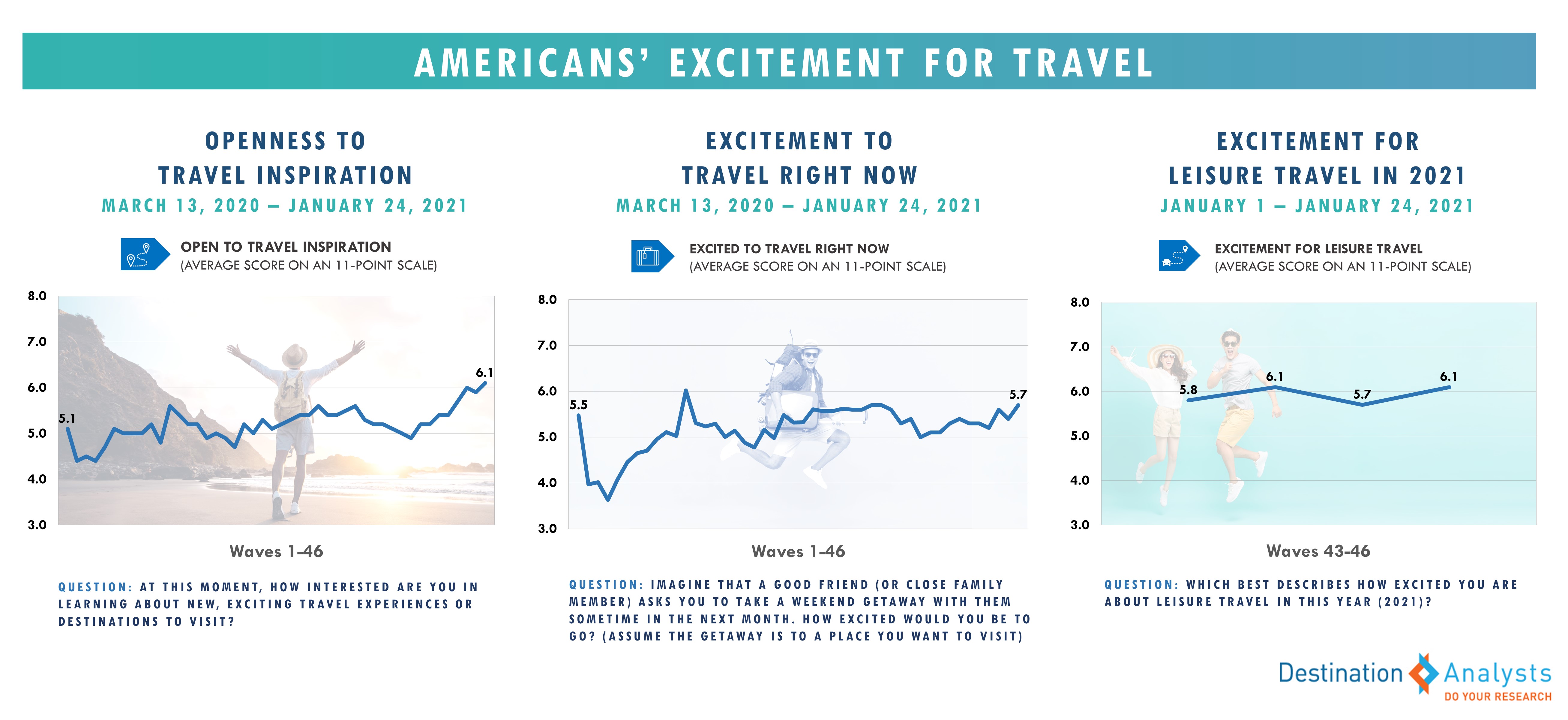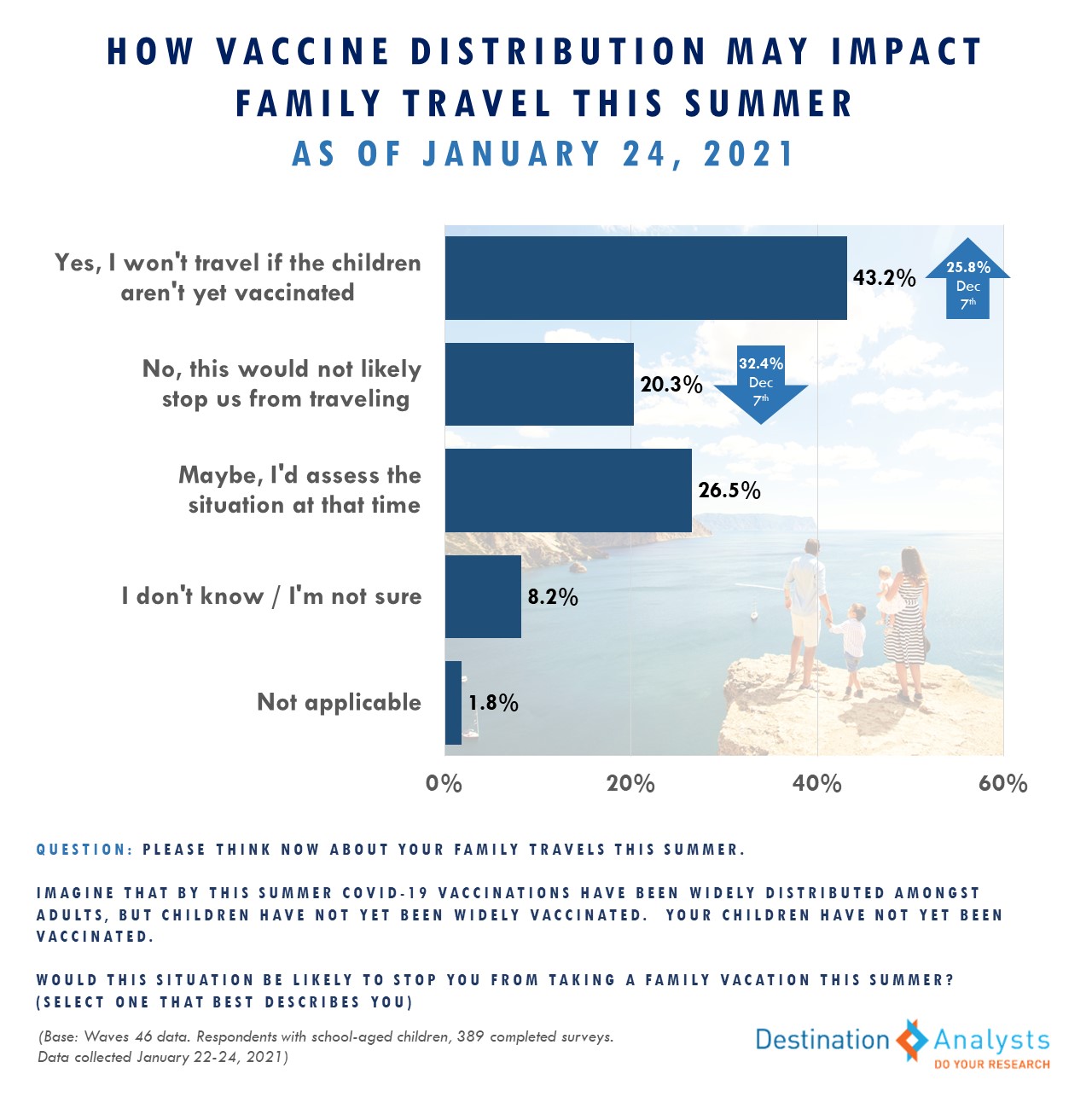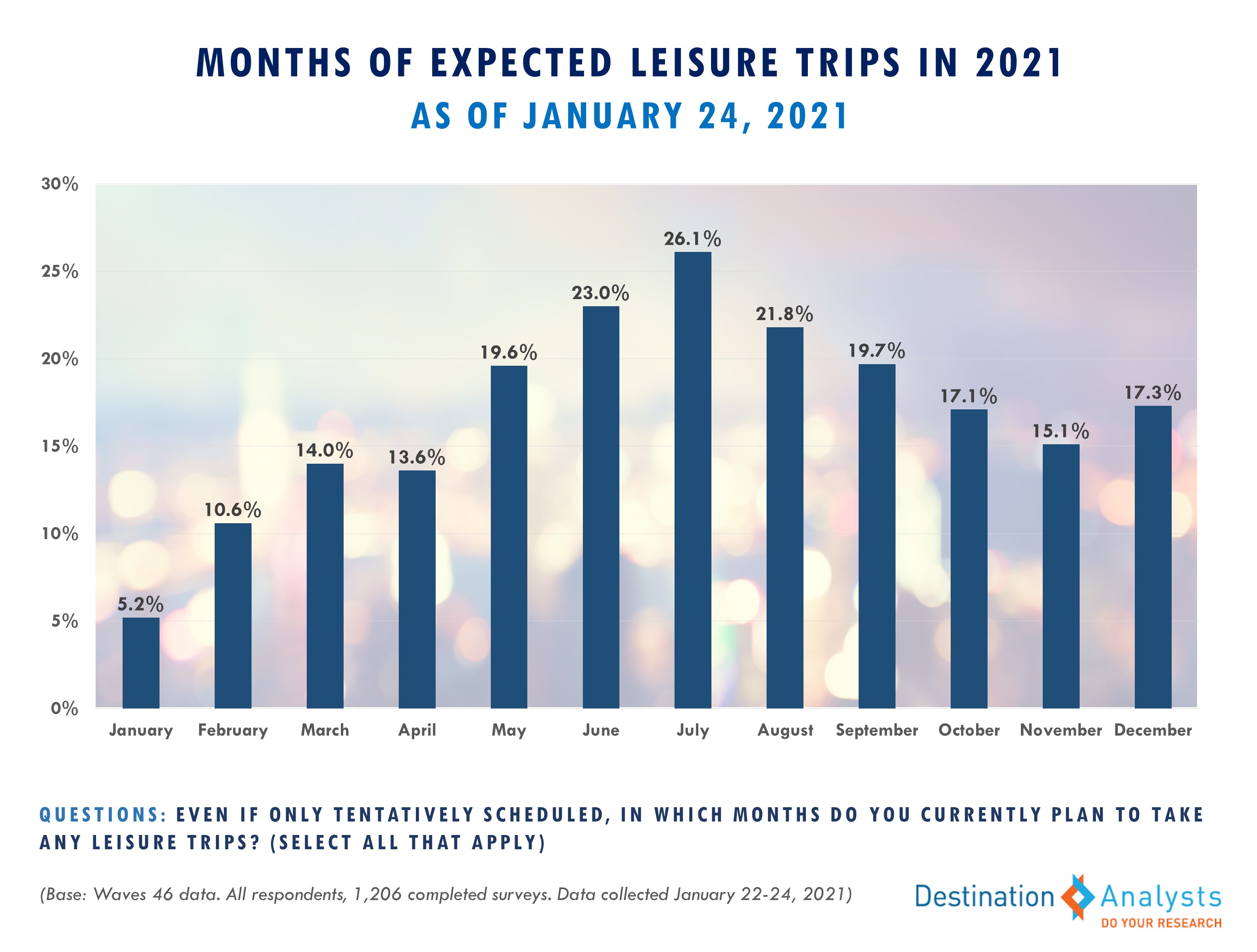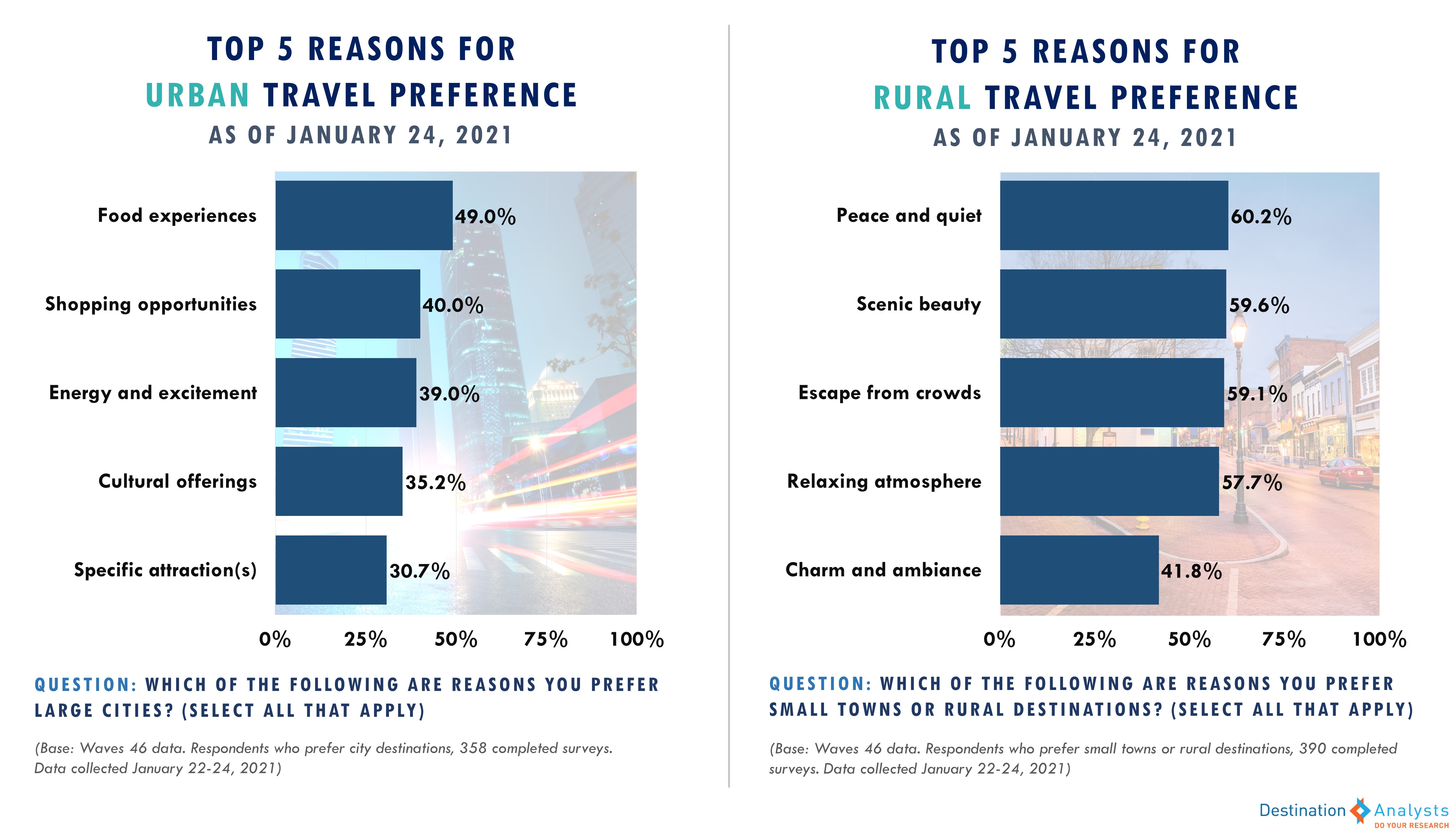Update on American Travel in the Period of Coronavirus—Week of January 25th
Anxiety about the pandemic is as high as ever right now, but driven by optimism about vaccine timelines, Americans keep seeing the light at the end of the tunnel grow larger and closer. This more hopeful outlook has lifted excitement about travel, with planned trips beginning to ramp up in May and urban destinations continuing to show signs of recovery.
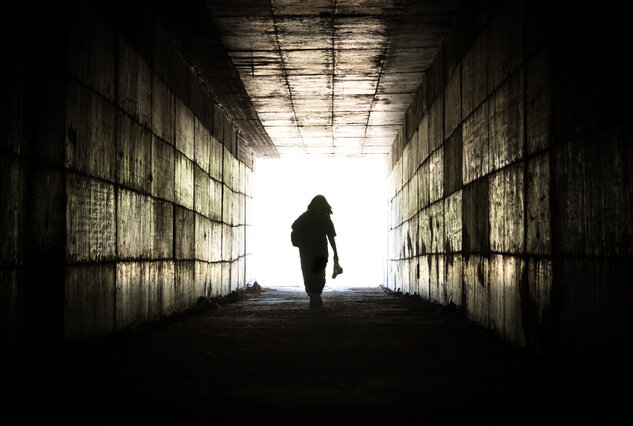
IMPORTANT: These findings are brought to you from our independent research, which is not sponsored, conducted or influenced by any advertising or marketing agency. Every week since March 15th, Destination Analysts has surveyed 1,200+ American travelers about their thoughts, feelings, perceptions and behaviors surrounding travel in the wake of the coronavirus pandemic, and explored a variety of topics. The findings presented below represent data collected January 22nd-24th.
Key Findings to Know:
- Americans’ anxiety about the pandemic is up. The percentage of Americans highly concerned about personally contracting the virus, their friends or family contracting the virus, the pandemic’s impact on their personal finances and its impact on the national economy overall all increased this week—and, in fact, are among the highest levels they have ever been.
- But Americans also keep growing more optimistic about the future. This week, 35.0% said they feel the pandemic situation is going to get better in the next month. The only other times this measure of optimism reached this level were the weeks of May 4th and June 8th.
- This more hopeful outlook for the near future has lifted excitement about travel. Americans’ excitement levels for potential getaways and their 2021 travel vision, as well as their openness to travel inspiration, all grew and are in a pandemic-era high period.
- In a measurement of “pent up demand,” two-thirds of those whose typical travel patterns were altered by the pandemic say they miss traveling “very much,” and now 22.2% of them say they are going to travel more in 2021 to make up for lost time—up from 18.6% last week. Meanwhile, 50.9% confirm they will return to their pre-pandemic levels of traveling.
- In the last week alone, 38.7% day-dreamt about leisure travel, 30.3% talked about travel with friends or relatives and 27.0% researched travel ideas online.
- Americans continue to rate travel and leisure activities as safer than they ever have since the start of the pandemic.
- The availability and distribution of a COVID-19 vaccine remains a primary contributor to the growing optimism Americans are feeling about travel. Two-thirds say the vaccines are making them more optimistic about life returning to normal in the next six months and nearly 60% say they are making them more optimistic that they can travel safely within that same period. More American travelers than ever are saying they will get vaccinated against COVID-19 (66.3%).
- The pace of vaccine distribution will impact the timing of travel volume and trip types. For example, when parents of school-aged children were posed a scenario in which their own and other children had not been vaccinated by this summer, 43.2% of them said that they will NOT travel with the kids in this situation. This is up nearly 18 percentage points from when we last asked this question the week of December 7th.
- You can see vaccine expectations and how Americans envision the year in their current travel plans. The percent of Americans with leisure trips planned begins to jump up in May. Right now, 26.1% of American travelers say they already have plans to travel in July.
- In gauging Americans’ march “back to normal,” we continue to see signs of urban destinations recovering. New York, Las Vegas and Los Angeles comprise 3 of the top 5 places Americans say they want to visit this year.
- However, it appears that rural areas will continue to be strong competitors to cities in a way not seen before the pandemic. Those traveling over the next three months are as likely (even slightly more so) to go to small towns and rural areas as cities and metropolitan areas, and while 32.6% of American travelers say their travel preferences favor visiting cities, 29.7% say their preference is for rural.
As confirmation of new strains of COVID being detected make headlines, Americans’ anxiety about the pandemic is up. The percentage of Americans highly concerned about personally contracting the virus (74.3%), their friends or family contracting the virus (79.6%), the pandemic’s impact on their personal finances (58.3%) and its impact on the national economy overall (86.7%) all increased this week—and, in fact, are among the highest levels they have ever been. But Americans also keep growing more optimistic about the future, seemingly seeing the light at the end of the tunnel grow larger and closer. This week, 35.0% said they feel the pandemic situation is going to get better in the next month. The only other times this measure of optimism reached this level were the weeks of May 4th and June 8th. Meanwhile, feelings that the pandemic situation will worsen in the next month dropped again and is now at 38.1%.
This more hopeful outlook for the near future has lifted excitement about travel in spite of current anxieties. Although 48.2% of American travelers still have lost their taste for travel for the time being, their excitement levels for potential getaways and their 2021 travel vision, as well as their openness to travel inspiration, all grew and are in a pandemic-era high period (5.7, 6.1 and 6.1 respectively on a scale from 0-10). Well over half are in a ready-to-travel mindset (54.3%). In a measurement of “pent up demand,” two-thirds of those whose typical travel patterns were altered by the pandemic say they miss traveling “very much,” and now 22.2% of them say they are going to travel more in 2021 to make up for lost time—up from 18.6% last week. Meanwhile, 50.9% confirm they will return to their pre-pandemic levels of traveling. In the last week alone, 38.7% day-dreamt about leisure travel, 30.3% talked about travel with friends or relatives and 27.0% researched travel ideas online. This week, a record 43.7% of American travelers say that discounts can motivate them to take a trip they had not previously considered. Americans also continue to rate travel and leisure activities as safer than they ever have since the start of the pandemic.
The availability and distribution of a COVID-19 vaccine remains a primary contributor to the growing optimism Americans are feeling about travel. Two-thirds say the vaccines are making them more optimistic about life returning to normal in the next six months and nearly 60% say they are making them more optimistic that they can travel safely within that same period. More than a third now say they have begun planning or booking travel in anticipation of wider vaccine distribution. More American travelers than ever are saying they will get vaccinated against COVID-19. This week, 66.3% said they will take one of the available vaccines, and nearly one-third expects to be inoculated by the end of March. Interestingly, this anticipation appears to make them more likely to say they will not be traveling until they get vaccinated (51.5%—up over 10% in the last 6 weeks) or distribution is wider (52.0%—up over 5% in the last 3 weeks). Given this, the pace of vaccine distribution will impact the timing of travel volume and trip types. For example, when parents of school-aged children were posed a scenario in which their own and other children had not been vaccinated by this summer, 43.2% of them said that they will NOT travel with the kids in this situation. This is up nearly 18 percentage points from when we last asked this question the week of December 7th (25.8%).
You can see vaccine expectations and how Americans envision the year in their current travel plans. As shown in the infographic below, the percent of Americans with leisure trips planned begins to jump up in May. Right now, 26.1% of American travelers say they already have plans to travel in July. Over the next three months, travel looks like it will be relatively muted compared to the rest of the year, although approximately 47% of American travelers anticipate taking a trip in the next 12 weeks. Nearly 75% of these trips are expected to be within 250 miles of these travelers’ residences.
In gauging Americans’ march “back to normal,” we continue to see signs of urban destinations recovering. New York, Las Vegas and Los Angeles comprise 3 of the top 5 places Americans say they want to visit this year. However, it appears that rural areas will continue to be strong competitors to cities in a way not seen before the pandemic. Those traveling over the next three months are as likely (even slightly more so) to go to small towns and rural areas (38.7%) as cities and metropolitan areas (36.3%), and while 32.6% of American travelers say their travel preferences favor visiting cities, 29.7% say their preference is for rural. The pandemic remains a driver of this—56.3% of those that say they prefer rural destinations say COVID-related safety concerns are an important factor to their preference. Other top reasons those with rural preference orient to these destinations include peace and quiet, scenic beauty, escaping from crowds, relaxing atmosphere and these destinations’ charm and ambiance. Meanwhile, those with an urban preference want the food, shopping, cultural offerings, attractions and energy and excitement offered.

